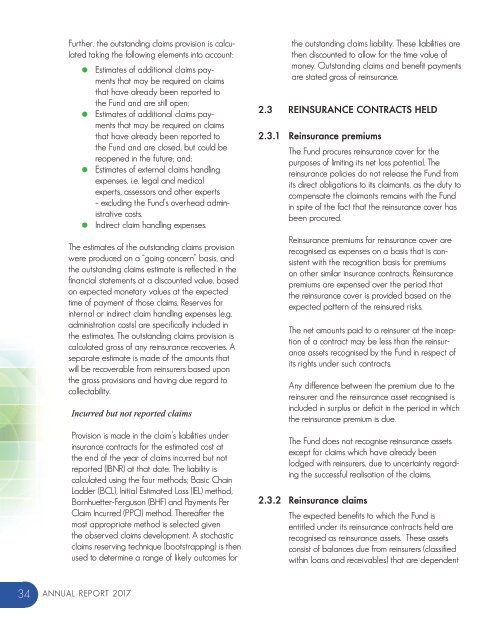compressed_Annual Report 2016-ilovepdf-compressed
Create successful ePaper yourself
Turn your PDF publications into a flip-book with our unique Google optimized e-Paper software.
Further, the outstanding claims provision is calculated<br />
taking the following elements into account:<br />
Estimates of additional claims payments<br />
that may be required on claims<br />
that have already been reported to<br />
the Fund and are still open;<br />
Estimates of additional claims payments<br />
that may be required on claims<br />
that have already been reported to<br />
the Fund and are closed, but could be<br />
reopened in the future; and;<br />
Estimates of external claims handling<br />
expenses, i.e. legal and medical<br />
experts, assessors and other experts<br />
– excluding the Fund’s overhead administrative<br />
costs.<br />
Indirect claim handling expenses.<br />
The estimates of the outstanding claims provision<br />
were produced on a “going concern” basis, and<br />
the outstanding claims estimate is reflected in the<br />
financial statements at a discounted value, based<br />
on expected monetary values at the expected<br />
time of payment of those claims. Reserves for<br />
internal or indirect claim handling expenses (e.g.<br />
administration costs) are specifically included in<br />
the estimates. The outstanding claims provision is<br />
calculated gross of any reinsurance recoveries. A<br />
separate estimate is made of the amounts that<br />
will be recoverable from reinsurers based upon<br />
the gross provisions and having due regard to<br />
collectability.<br />
Incurred but not reported claims<br />
Provision is made in the claim’s liabilities under<br />
insurance contracts for the estimated cost at<br />
the end of the year of claims incurred but not<br />
reported (IBNR) at that date. The liability is<br />
calculated using the four methods; Basic Chain<br />
Ladder (BCL), Initial Estimated Loss (IEL) method,<br />
Bornhuetter-Ferguson (BHF) and Payments Per<br />
Claim Incurred (PPCI) method. Thereafter the<br />
most appropriate method is selected given<br />
the observed claims development. A stochastic<br />
claims reserving technique (bootstrapping) is then<br />
used to determine a range of likely outcomes for<br />
the outstanding claims liability. These liabilities are<br />
then discounted to allow for the time value of<br />
money. Outstanding claims and benefit payments<br />
are stated gross of reinsurance.<br />
2.3 REINSURANCE CONTRACTS HELD<br />
2.3.1 Reinsurance premiums<br />
The Fund procures reinsurance cover for the<br />
purposes of limiting its net loss potential. The<br />
reinsurance policies do not release the Fund from<br />
its direct obligations to its claimants, as the duty to<br />
compensate the claimants remains with the Fund<br />
in spite of the fact that the reinsurance cover has<br />
been procured.<br />
Reinsurance premiums for reinsurance cover are<br />
recognised as expenses on a basis that is consistent<br />
with the recognition basis for premiums<br />
on other similar insurance contracts. Reinsurance<br />
premiums are expensed over the period that<br />
the reinsurance cover is provided based on the<br />
expected pattern of the reinsured risks.<br />
The net amounts paid to a reinsurer at the inception<br />
of a contract may be less than the reinsurance<br />
assets recognised by the Fund in respect of<br />
its rights under such contracts.<br />
Any difference between the premium due to the<br />
reinsurer and the reinsurance asset recognised is<br />
included in surplus or deficit in the period in which<br />
the reinsurance premium is due.<br />
The Fund does not recognise reinsurance assets<br />
except for claims which have already been<br />
lodged with reinsurers, due to uncertainty regarding<br />
the successful realisation of the claims.<br />
2.3.2 Reinsurance claims<br />
The expected benefits to which the Fund is<br />
entitled under its reinsurance contracts held are<br />
recognised as reinsurance assets. These assets<br />
consist of balances due from reinsurers (classified<br />
within loans and receivables) that are dependent<br />
34<br />
ANNUAL REPORT 2017





